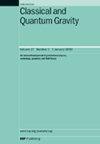A MIMO system identification approach for the longitudinal control of the filter cavity of the advanced virgo gravitational-wave detector
IF 3.6
3区 物理与天体物理
Q2 ASTRONOMY & ASTROPHYSICS
引用次数: 0
Abstract
The sensitivity of the second generation ground-based gravitational-wave detectors is mostly limited by quantum noise (QN). The injection of frequency-dependent squeezed vacuum states into the output port of the interferometer has been shown to reduce QN across the entire detector bandwidth. Frequency dependent squeezed states are generated by reflecting a frequency independent squeezed states off a detuned optical cavity: the phase response of the cavity rotates the squeeze angle as a function of frequency. The precision of the longitudinal control of the such cavity, known as filter cavity, is one of the key parameters affecting the QN suppression factor. The target longitudinal control precision was achieved by simultaneously acting on both the cavity length and the frequency of the squeezing main laser. In this scenario, the analysis of this system requires a Multiple-Input Multiple-Output (MIMO) system model. In this work, we demonstrate that a MIMO model is required and show that a MIMO system identification technique is effective to characterize the system and improve its robustness. Ultimately we show that these techniques allow the design of robust filters that can keep the cavity residual length fluctuations below 1 pm, allowing for a QN reduction of 4.5 dB at high frequencies and 2 dB at low frequencies in the Advanced Virgo interferometer.先进处女座引力波探测器滤光腔纵向控制的MIMO系统辨识方法
第二代地面引力波探测器的灵敏度主要受到量子噪声的限制。在干涉仪的输出端注入频率相关的压缩真空态,可以降低整个探测器带宽上的QN。频率相关的压缩态是通过反射失谐光腔的频率无关的压缩态而产生的:腔的相位响应旋转压缩角作为频率的函数。这种被称为滤波腔的腔体的纵向控制精度是影响QN抑制因子的关键参数之一。通过同时作用于压缩主激光器的腔长和频率,实现了目标的纵向控制精度。在这种情况下,该系统的分析需要一个多输入多输出(MIMO)系统模型。在这项工作中,我们证明了需要一个MIMO模型,并表明MIMO系统识别技术可以有效地表征系统并提高其鲁棒性。最终,我们证明了这些技术允许设计出鲁棒滤波器,可以将腔体剩余长度波动保持在1 pm以下,从而允许在高级室女座干涉仪中在高频时减少4.5 dB,在低频时减少2 dB。
本文章由计算机程序翻译,如有差异,请以英文原文为准。
求助全文
约1分钟内获得全文
求助全文
来源期刊

Classical and Quantum Gravity
物理-天文与天体物理
CiteScore
7.00
自引率
8.60%
发文量
301
审稿时长
2-4 weeks
期刊介绍:
Classical and Quantum Gravity is an established journal for physicists, mathematicians and cosmologists in the fields of gravitation and the theory of spacetime. The journal is now the acknowledged world leader in classical relativity and all areas of quantum gravity.
 求助内容:
求助内容: 应助结果提醒方式:
应助结果提醒方式:


